Elixir Gin is a gin like no other I have tasted. The gin from Berlin relies heavily on woodruff, a generally popular herb in Germany. However, the herb is rarely used in gin. Among the few brands that use woodruff for flavoring, I have yet to find one where the sweet and earthy flavor of the herb is so dominant.
Elixier Gin is best when served on the rocks with fresh lemon. At 40% vol., it is also quite enjoyable when drunk neat at room temperature. The unique combination of woodruff, juniper, and 14 other botanicals leads to a mildly herbaceous Gin with a distinct sweet note.
When opening the bottle, you can immediately smell the subtle, sweet scent of woodruff. The nose is quite earthy and sweet with herbal notes. Overall the aroma is dominated by woodruff, juniper, and citrus fruits. In the background, you can detect hints of fennel, anise, and mint. It is a fresh but not too complex nose.
When you pour it into a glass, you immediately notice the high viscosity of this gin. When swirling it you can see how slowly it moves, almost like oil. Especially interesting because it is filtered six times.
On the palate, the two main components are juniper and a subtle earthy sweetness coming from woodruff. The comparably high amount of sweetness in the gin also explains the oily appearance inside the glass. - The natural and not overpowering woodruff taste is also present when making a Gin and Tonic with this Gin.
Once you add ice, the juniper and woodruff notes are muted. They do not disappear entirely but are dialed down quite a bit.
The flavors of the other botanicals benefit from this, and the overall taste is much more balanced. Anise, fennel, and coriander seeds provide a spicy and earthy flavor.
Add a slice of lemon or lemon peel to the gin and see how well it pairs with the woodruff notes. In combination with the ubiquitous sweetness, this is a delicious way to enjoy the gin. In my opinion, even the best.
How does Elixier Gin perform in some of the most popular Gin Cocktails? Read our opinion here:
I would recommend using Fevertree Indian Tonic Water to go with Elixier Gin. Serve it over a generous amount of ice, garnished with a slice of lemon and a sprig of mint.
The most noteworthy part for me is that the woodruff aroma seems even more intense in a G&T than when drinking the gin neat. Those earthy woodruff notes create an unusual and unique flavor I never had in a Gin and Tonic before.
The freshness of lemon and mint helps to highlight these special notes. Overall, the Gin and Tonic is a bit too sweet for me.
We tried Elixier in a Gin Sour and Gin Fizz and both drinks were excellent. In my opinion, the Gin Fizz was the best cocktail we made with this gin. I served it with a lemon peel twist and a sprig of fresh mint.
The subtle sweetness is not an obstacle but helps to establish the balance between sweet and sour.
The earthy woodruff notes make the cocktail unique and make the classic fizz recipe even better.
I love Negronis, but in this case, it was the most disappointing drink we made with this gin. The cocktail was generally too sweet, and it was almost impossible to create balance since both Campari and vermouth are as well rather sweet ingredients.
The woodruff flavor also doesn't blend well with the bitter notes of the Campari. Even the excellent Antica Formula vermouth from Carpano could not save it.
We also tried Elixier in a hot cocktail called “Heißer Kirmes Apfel.” This one tastes fantastic, and you can easily make it at home. The recipe was developed and tested by the guys from Elixier and is perfect for a cold winter day.

Elixir comes in a special bottle design. The narrow, angular, rectangular, and somewhat whimsical bottle holds a total of 500ml. The old-school design of the label is entirely in black and white, reminiscent of the fairs and circuses of the 1920s. The bottle is closed with a natural cork which further enhances the vintage impression.
Although a bottle contains only half a liter of gin, it feels larger in the hand. This is mainly due to the unusual shape and the glass thickness which is therefore required.
The list of botanicals is long. In total, Elixier Gin contains 15 different botanicals that create a round and fresh flavor that is dominated by juniper and woodruff.
The 13 remaining botanicals include fennel, coriander seeds, citrus fruits, and anise. This mix complements the woodruff and juniper flavors well and creates a distinct sweet and herbal flavor profile.
Most of these botanicals are commonly known, but some of you may never have heard of woodruff before - at least if you have not grown up in Germany. There, woodruff-flavored drinks and sweets are actually pretty popular.
When I first heard about Elixier, I was instantly intrigued. A gin based on woodruff certainly is something special. And because so many people don't even know this herb exists, I will give more detail on what woodruff actually is.
Woodruff – also known as “Master of the woods” (in German: Waldmeister) – has a sweet and earthy aroma, almost hay-like. Some also compare it to freshly mowed grass. The flavor is so intense that you might think it is artificial. - But it is not.
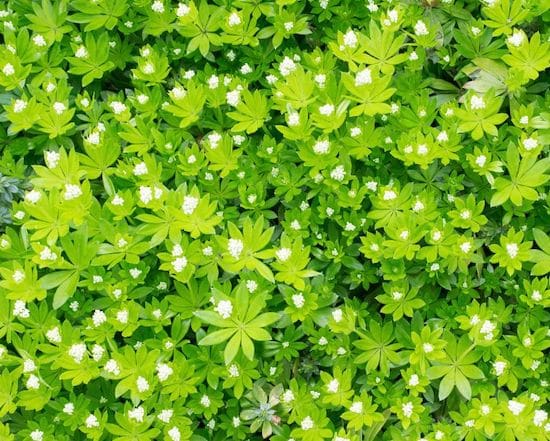
There are many medical use cases for woodruff: it is beneficial for strengthening your heart and helps with headaches, migraines, abdominal cramps, kidney stones, and even liver diseases.
Germans have a long tradition of woodruff-flavored drinks – alcoholic and non-alcoholic. You can get woodruff-flavored lemonade, ice pops, sweets, and beer.
The Elixier Gin brand currently sells four different products. Besides the classic woodruff-flavored gin they also produce quince gin, Sloe Gin, and winter gin.
An homage to childhood memories. This introduction phrase from the brand sets the tone. This gin is fun. Its packaging is unique, and so is the taste.
Due to it being sweet and quite unusual, I would classify it as a New Western Dry Gin. This type of gin pushes the limits and implements new and unique ideas.
Elixir gin is a welcome change from classic London Dry Gins. The woodruff notes make this contemporary gin something truly special. The somewhat overly dominant sweetness and the resulting incompatibility in some classic gin cocktails prevent a higher rating.
The best way to enjoy this gin is on ice, garnished with lemon peel or a slice of lemon.
The Margarita Cocktail is one of the most famous Mexican alcoholic beverages. Especially in Northern America, where it led the list of popular cocktails for two consecutive years (2016 & 2017), according to market research company Nielsen CGA.
It is hardly surprising this summer cocktail is such a crowd-pleaser. The blend of tangy fresh lime juice, citric orange notes, and a bold tequila flavor combined with salt is simply delicious.
With 25% ABV or slightly above, depending on your choice of tequila, this drink is not only delicious, but it also packs a punch!
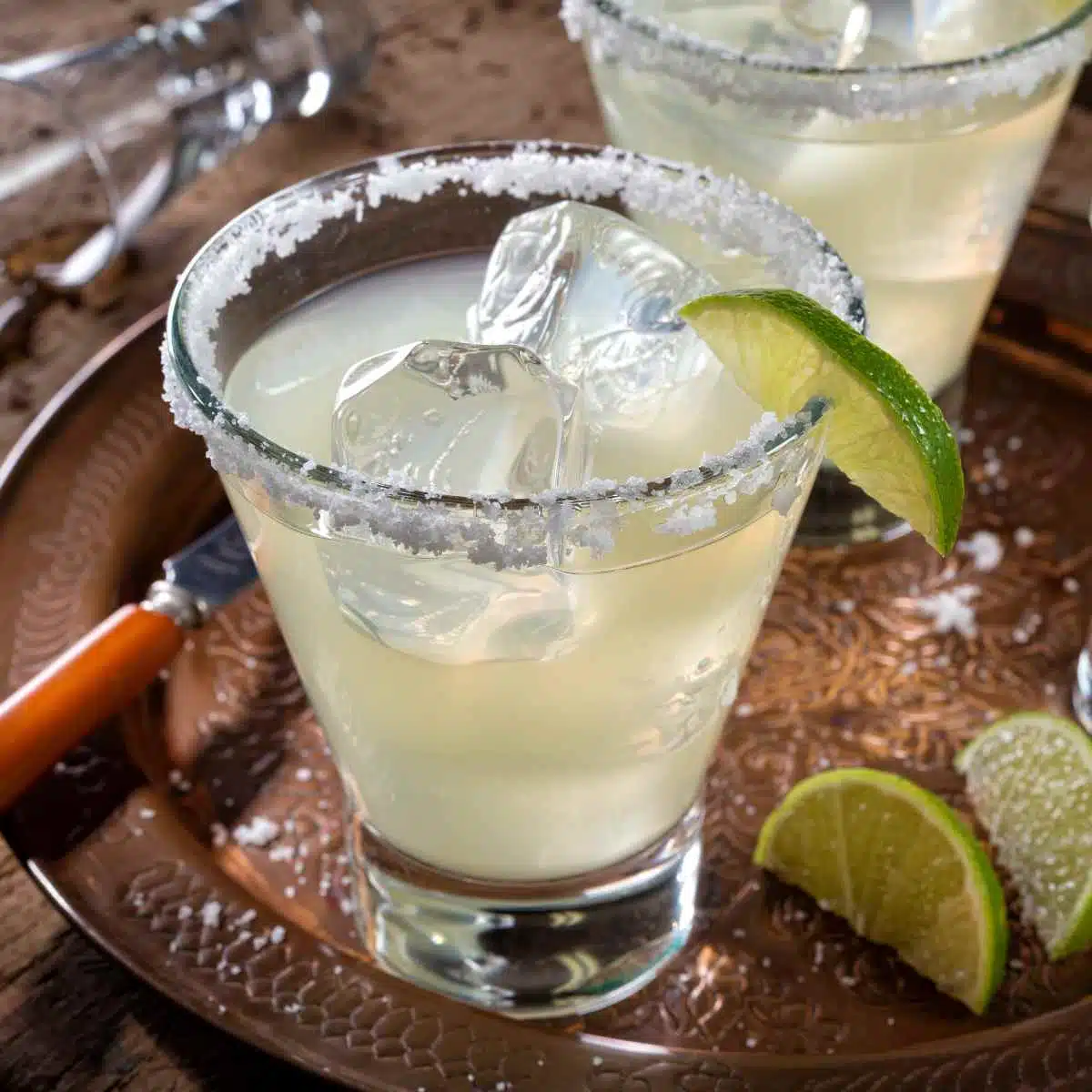
The Margarita Cocktail is a simple mix of tequila, triple sec, and lime with a splash of syrup. Looking at this short list of ingredients, you can see that there's nowhere to hide. Quality is key here, so stay away from anything that says Margarita Mix on the label and use the ingredients instead for the best results:
In addition to the ingredients listed, you need a cocktail shaker, a strainer, some ice, and a rocks glass. You can also go with the characteristic Margarita glass, but that's more common for fruity riffs.
When your equipment is all set, I recommend using lots of ice in your cocktail shaker and also for serving. Don't go with crushed ice, though. It will water down this fabulous cocktail too much.
Stay away from premixed stuff and bottled citrus juice. A Margarita relies on these zesty, fresh flavors. Also, consider putting salt only on one side of the rim, or serving the drink it with a biodegradable straw. As unlikely as it seems to me, not everyone likes the salt with every sip.
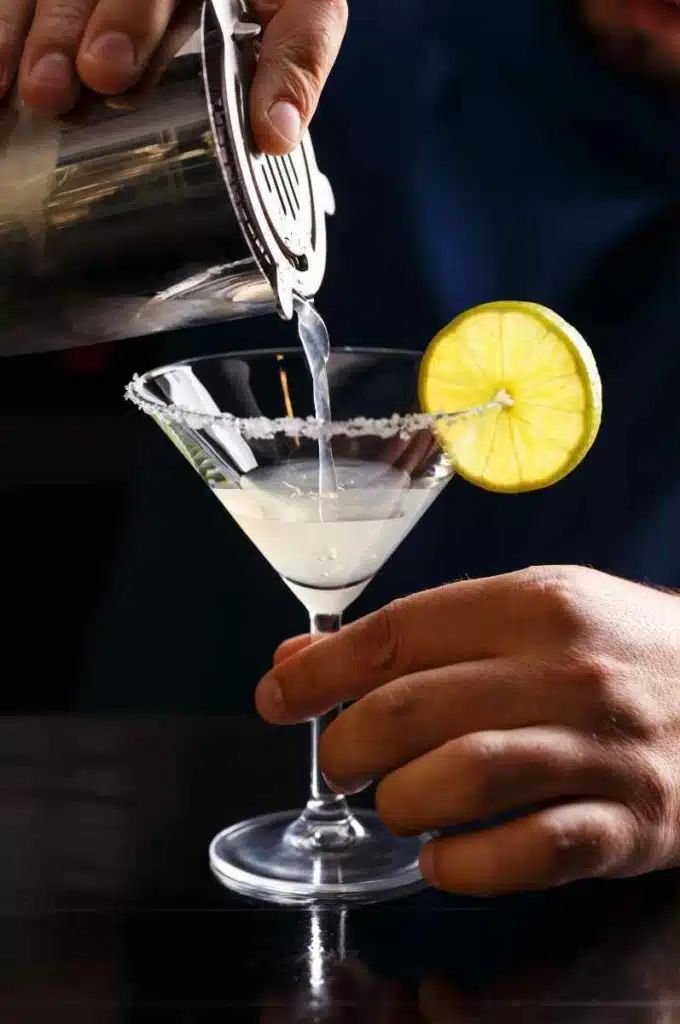
Apart from the described Tommy's Marg, there are many more possibilities to tweak the original formula. For instance, you can omit the syrup and make a drier version or replace tequila with another agave spirit for a smoky Mezcal Margarita. Other options are:
Yes, triple sec is absolutely necessary if you want your classic Margarita to taste as it does in your favorite cocktail bar. However, it is a question that comes up frequently for multiple reasons.
One is the so-called Margarita mix, which saves you the trouble of using triple sec, limes, and syrup but brings you a below-average drink.
The other reason is a riff called Tommy's Margarita, created in the 1990s. The recipe omits the triple sec and is a simplified version of the classic.
However, as I want to emphasize once again, orange liqueur -in form of triple sec or at least Curaçao- is an essential part of the original Margarita recipe. When leaving this intensely orange-flavored element off, you will never achieve the authentic flavor of the traditional Mexican cocktail.
The first known written documentation of a Margarita recipe was in the Esquire magazine. In their December 1953 issue, they printed a recipe asking for an ounce of tequila, a dash of triple sec, and the juice of half a lime. Yet, the recipe likely is a few decades older than that.
One of the very early stories is from Baja California, Mexico. According to this, one Mr. Herrera supposedly created the cocktail in 1938. He prepared a Margarita for a customer allergic to many spirits but not tequila.
With a drink as famous and beloved as the classic Margarita, many would have liked to be linked to its history. It is hardly surprising that there are various stories and claims about who made it first. It is impossible to tell which is true, but I want to share some more theories:
Jose Cuervo, one of the most renowned tequila producers, says the cocktail was invented for a Mexican showgirl in 1938. There are numerous similar accounts and claims by others for who the drink may or may not have been created.
Historian David Wondrich makes a general connection between the Margarita and Daisy Cocktails. That doesn't seem farfetched, considering that Margarita is the Spanish word for Daisy, but he couldn't shed light on the invention of the drink itself.
What all stories have in common is the timeframe (sometime in the late 1930s or early 1940s) and the approximate location (somewhere around Acapulco).
Regardless of the true origin of the Margarita, it took until the 70s for the recipe finally take off. But boy, taking off it did. Today, we have National Margarita Day, held on February 22nd, and it's also the ultimate drink for all Cinco de Mayo celebrations.
Based on a recipe from Jacobus "Bobby" Alfons, Bobby's Schiedam Dry Gin is inspired by two worlds: South-East Asia and Europe. In 2012 Sebastian and David van Bokkel found the recipe, and after only two years of testing, they released Bobby's Gin with the help of Herman Jansen Distillery, located in Schiedam.
Bobby's has a complex bouquet with many layers. An exotic aroma profile led by lemongrass, cinnamon, and rose hip. On the palate, these exotic spices blend with coriander, juniper, and cloves to create an invigorating spirit best served in a Gin and Tonic.
It's a fantastic gin of excellent quality that brings Asian flavors together with a European spirit. Read our review to find out more about Bobby's.
Once you open the bottle, you can smell the fresh and fragrant aroma of Bobby's Gin. The nose of the Schiedam Dry Gin is very floral, with notes of rose hip mixed with lemongrass and cinnamon. In the background, you can also detect spicy notes from cloves and fennel.
By swirling it in the glass, you will notice the unusually high viscosity, which strongly reminds me of Genever. That only makes sense because the Jansen Distillery has been famous for distilling Genever for generations.
On the palate, you get more rosehip and fresh and intense citrus notes from lemongrass that dominate the gin. Strong notes of cloves and fennel come through as well as piney juniper flavors. Overall, all the flavors are quite pronounced and bold. -That's unusual, but I like it.
The finish is also not subtle at all. It's very long with spicy and peppery notes of cubeb pepper and hints of basil.
Serve chilled or on ice, the floral rose hip notes fade slightly. That happens for all flavors because, in general, aromas and flavors develop better at warmer temperatures.
The profile shifts slightly and an exotic combination of lemongrass and cinnamon comes through. For sipping, I recommend trying both neat and on ice. Personally, though, I prefer the fuller, more complex flavors when served neat.
That's how Bobby's performs in three of the best Gin Cocktails:
Bobby's Gin is far up on our list of the best gins for a Gin and Tonic. It's particularly great when you look for less junipery options. While the official recommendation for tonic water is Fever Tree Indian Tonic, I prefer Mediterranean Tonic Water.
Garnished with freshly sliced orange peel, I'm sure this highball will blow your socks off. So here's my suggestion for the perfect serving. I prefer a ratio of 1:3 of gin to tonic water, but sometimes I also reduce the amount of tonic to 1:2 to let the spirit shine.
The combination of Campari, sweet vermouth, and Bobby's Gin also works nicely. The bold flavors are strong enough to shine through the bittersweet combination of vermouth and Italian red bitter.
As much as I like Negronis and Bobby's, I have to say that the Gin & Tonic was much better. In other words, Bobby's is a good option for a Negroni but not the best.
I was curious to taste Bobby's in a Gin Fizz and wasn't disappointed. The bold and exotic flavors paired nicely with fresh lemon juice and sugar syrup. However, I liked it even more when using spiced syrup instead of regular simple syrup.
Lemongrass, rose hip, cinnamon, and lemon create a wonderful summer-inspired flavor. The refreshing carbonation from chilled soda water made it even more refreshing.
The brown and grey smoked glass used for Bobby's Gin is a modern interpretation of the original genever bottle. The printed pattern on the bottle, a so-called ikat, symbolizes a traditional Indonesian weaving technique used for Sarongs.
The bottle stopper is quite large and made of natural wood. The bottle is closed with a blue band that fixes the wooden lid on the bottle.
On the label is the slogan: "Best of both worlds, east and west". A reference to the origin of its recipe in honor of the grandfather of the founders.
The botanical selection in Bobby's Schiedam Dry Gin is special. Yet, the list of plants and herbs used doesn't look overly experimental at first sight. The spirit is flavored with the following botanicals:
Bobby's Gin is named after the grandfather of the guys that brought the gin to life. Bobby was born and raised in Indonesia and grew up with the vibrant spices typical for South-East Asia. When he fell in love with Genever, he started pairing traditional Indonesian spices with this Dutch spirit.
In 2012, Sebastian van Bokkel and David van Bokkel discovered the old Pinang Raci (Engl. spice mixture) recipe their grandfather used to infuse spirits. Intrigued, they decided to turn this spice mix into a product with the help of the famed Genever producer at Herman Jansen Distillery in Schiedam.
After two years of testing and tweaking recipes, they released Bobby's Gin in 2014. Since then, the unconventional flavors gained a loyal fan base. Merely two years later, they released a second product: a real Genever (or Jenever).
After experimenting with the different spices in the Pinang Raci of their grandfather, the two brothers and master distiller Ad van der Lee came up with a variety of special products that re-interpret the spice mix. The first one was released in 2022 and is called "Pinang Raci Spice Blend No.1".
Bobby's Gin is produced at Herman Jansen Distillery in Schiedam, Netherlands. The Jansen family makes Genever in the 8th generation, and they know exactly how to work with juniper-based spirits.
The city of Schiedam, often referred to as the capital of Genever, has been the focal point of the juniper distillate since the 18th century. Therefore it's also the birthplace of gin as we know it today.
Herman Jansen and his family were at the forefront with their distillery "De Tweelingh". If you have the chance to visit Schiedam, take a short detour to the Genever museum. It offers extensive insight into the production of Genever and explains the difference to gin.
Bobby's is produced by distilling each of the eight botanicals separately using 300l and 600l copper stills. The resulting spirits are then blended and ultimately reduced to 42% ABV.
Bobby's Dry Gin is as far from the classic London Dry flavors as possible. It has a distinct aroma, bold flavors, and, overall, an unique flavor profile. It truly pushes the boundaries. So, if you're a fan of traditional, juniper-forward products, this one is not for you. For everyone else, Bobby's Gin is one of the most refreshing gins I have ever tasted.
There's a vegan alternative that you can use as a substitute in cocktails, called Aquafaba. But what is that? And how do you use Aquafaba in cocktails to create an equally smooth and foamy top?
Raw egg whites have been an essential cocktail ingredient for many decades. The first written record of a cocktail recipe with egg white appeared in Jerry Thomas's Bartender Guide, published in 1862.
It is often used in Sour cocktails like Gin Sour, Pisco Sour, or Whiskey Sour. And now, with an increasing demand for vegan options, there's a new product to substitute egg white in cocktails - Aquafaba.
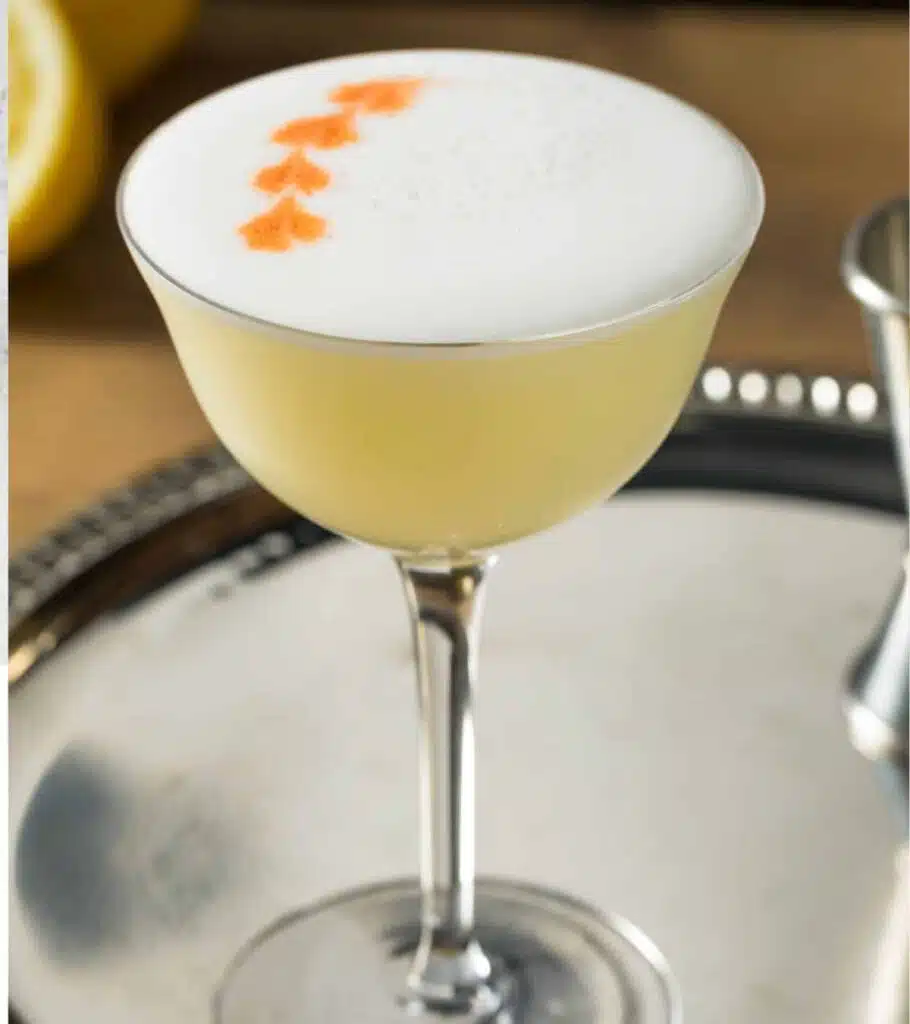
This vegan alternative to egg white basically is chickpea liquid. Usually, you would pour this liquid down the drain, but someone clever found a better use case for it.
It's a great way to create frothy, fluffy foams on cocktails, and it can be used as an egg white replacement when baking, too.
Another great benefit of Aquafaba, apart from being vegan, is that it doesn't have an odor. That makes it an excellent alternative for everyone who doesn't like egg whites or can't consume them because of their diet.
Using egg white in cocktails creates a beautiful velvety texture, a richer mouthfeel, and it smoothens the alcohol taste in your drink. It creates a thick and consistent white foam on top of your cocktail.
That upgrades the aesthetics of cocktails dramatically. And because it looks so pretty, you can find drinks with egg-white-foams all over social media.
And you won't go back to a cocktail without this creamy extra. Everyone who already had a cocktail with egg white surly will agree.
Aquafaba has been trending in bars across the globe for the past few years. As mentioned before, this vegan alternative for cocktails is obtained from canned chickpea liquid.
Discovered by chef Joel Roessel, the chickpea brine is an amazing emulsifier and foaming agent. So any time you need egg whites, whether for baking, cooking, or creating cocktails, you can substitute them with aquafaba.
And in times when we are becoming more conscious of what we consume, an alternative for raw egg white had to be found.
The name aquafaba may sound odd at first. It makes a lot of sense, though. It consists of the Latin words for water (aqua) and bean (faba).
When shaken, aquafaba loses any smell and becomes completely odorless. So that's a big plus when compared to egg white.
What aquafaba does not do is smoothen the alcohol taste. But for the majority of cocktails, this isn't a deal-breaker. It's still a brilliant alternative, and you definitely give it a try.
As mentioned, Aquafabs is a perfect replacement for egg white. It is the ideal ingredient for vegan cocktails and vegan cookies, waffles, or cakes.
That is thanks to its similar properties to egg white regarding emulsifying, binding, and thickening.
However, it's certainly no replacement if the egg is the main or only ingredient. So please don't try to create scrambled aquafaba. It won't work and doubtlessly won't taste right 😉
To use aquafaba in cocktails, strain it to get pure and smooth chickpea water without any lumps.
If you don't use it all at once, you can freeze it in 1oz portions for later use. In that case, defrost what you need right before mixing a cocktail.
Once you have nice and smooth aquafaba, it's ready to be turned into the perfect fluff.
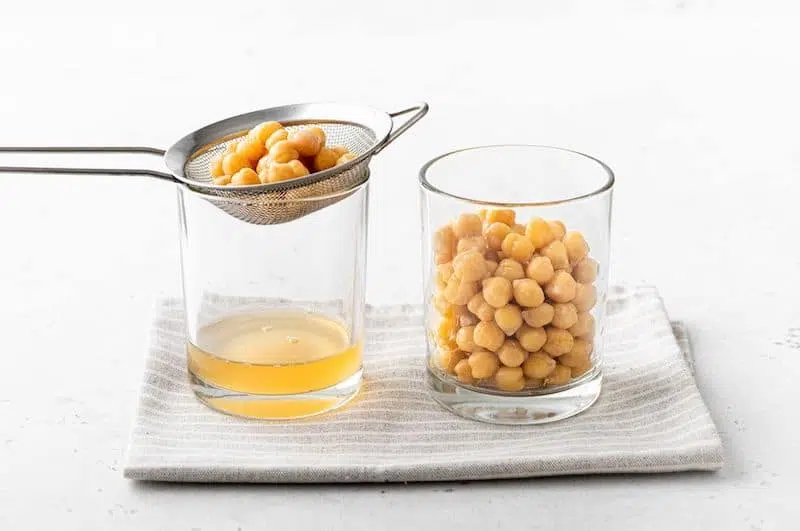
Cocktails containing egg whites usually use one whole egg white. Measuring this is easy. But how much aquafaba should you use to substitute an egg white?
I recommend starting with 0.75oz of Aquafaba and checking the results. In my opinion, this already creates plenty of foam if you do it correctly. Then shake the cocktail well and long enough to achieve the best results.
Pro tip: try to reverse-dry shake to further improve the result. To do that, put all ingredients into your cocktail shaker and add ice.
Now shake the drink hard for approx 30 seconds. Remove the ice from the shaker and shake again for another 15 seconds without ice to get a thicker, more consistent foam.
Finally, strain the cocktail in your chilled glass and enjoy the beautiful aquafaba foam.
More than 20 years ago, at Vinexpo 2001 in Bordeaux, London flair bartender Wayne Collins created a totally new version of the popular aperitif cocktail. His White Negroni is a French counterpart to the Italian classic, made with gin, Suze, and Lillet.
Quick Facts White Negroni
So let's see how you best make this bright version and how it came to life.

The White Negroni recipe replaces Campari and sweet vermouth, the dark and bittersweet components, with the lighter Suze and Lillet Blanc. Only the gin and the measurements remain the same - Collins decided to stick to the equal parts approach:
The number one most important thing when making a White Negroni is to chill all ingredients adequately while making sure that you don't water it down by using too much ice.
For this, you best keep all ingredients in the fridge before mixing your cocktail. When it's time for preparation, stir all ingredients in a mixing glass full of ice cubes. Stir for 20 to 25 seconds to achieve the ideal level of dilution from the melted ice.
Strain all ingredients into a rocks glass with one large, fresh, and ideally clear quality chunk of ice, and garnish your White Negorni with a lemon peel.
One more pro tip: Twist and squeeze your lemon peel while holding it over your drink before you discard it. That releases essential oils that will make your cocktail beautifully fragrant.
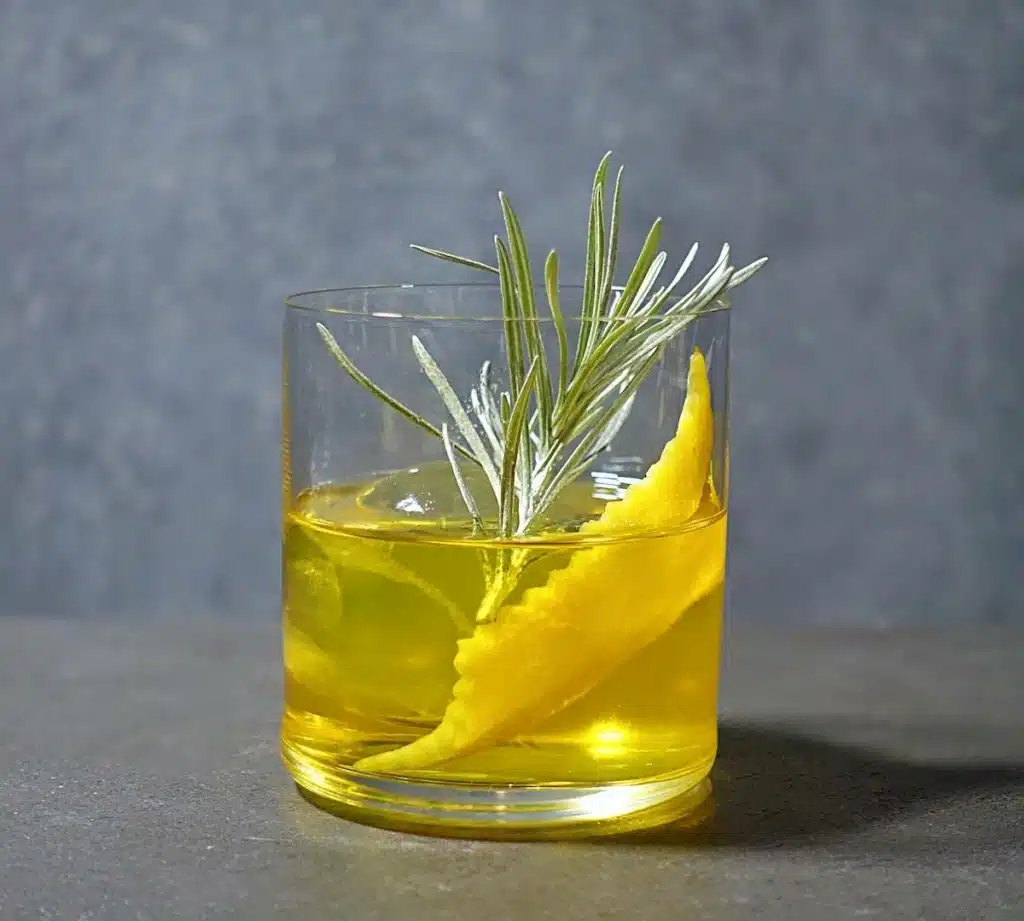
The White Negroni itself is already a variation of one of the most classy cocktail recipes. A dark ruby-colored traditional Negroni contains gin, Campari, and sweet vermouth. Other sensational variations of the Italian aperitivo are:
But there are many more worth trying. For a more exhaustive overview, check out these Negroni variations.
As mentioned earlier, Wayne Collins invented this cocktail while attending Vinexpo in Bordeaux. He went there to partake in an international cocktail competition and was traveling with Nico Blacknell, who, back then, was director of Plymouth Gin.
The day before the contest, they roamed local liquor stores to get ingredients to create a Negroni riff. Collins wanted to showcase French ingredients and chose Suze and Lillet Blanc to substitute Campari and sweet vermouth.
The gin part obviously was covered by Plymouth Gin, which they had plenty of back at their guest house.
But the White Negroni was by no means an instant hit. It took quite some time for the aperitif Cocktail to be recognized by mixologists. Even though Collins promoted it heavily, many bars simply didn't carry Suze or Lillet Blanc. And, as it turned out, neither did they plan on doing so any time soon.
Thus, he tried to grow its popularity organically and order his creation himself - over and over again. Eventually, this paid off.
The first big success of the White Negroni was when the famous Pegu Club in NYC listed it on their menu. However, Suze was not available in the United States, so the gentian Liqueur had to be smuggled in until 2012.
2012 Pernod Ricard finally decided to legally import Suze to the US, marking the beginning of the rise of the White Negroni. It quickly became one of the most famous twists on the classic Italian cocktail.
With the help of Pegu Staff member Jim Meehan, who mentioned it in his bestseller The PDT Cocktail Book, the recipe spread even faster. When released in 2011, this book was one of the main reasons the drink finally gained enough attention.
A dram of whiskey equals one-eighth of a fluid ounce (3.7ml), less than one teaspoon (5ml). That means a regular serve of whiskey (1.5 ounces) contains about 12 drams. But that's not what you get when you order a dram of whiskey in a bar. In Ireland, you get 35.5ml, in the UK between 25ml and 35ml, and in the US you typically get 45ml or 1.5 fluid ounces.
The term dram originates from Scotland and is a synonym for one serving of whiskey. However, a dram of whiskey is a very flexible unit to measure the amount of liquid.
Initially, it referred to a small amount, less than 5ml: 3.69ml or 1/8 of a fluid ounce. However, in daily use, that would be pretty impractical. Today, ordering a dram of whiskey will get you way more than that. How much depends on the region and your bartender.
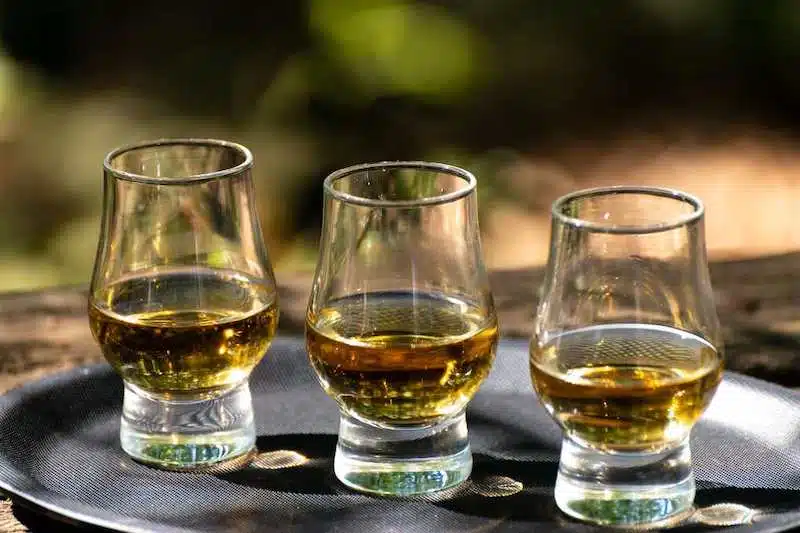
We previously established that a dram is a unit of measurement that equals 1/8 of a liquid ounce or 3.7 milliliters. The official definition of the word is a bit looser.
Renowned English dictionaries like the one from Cambridge define a dram as a small amount of a strong alcoholic drink. While that is pretty much what it is, it leaves a lot of room for interpretation.
In real life, the term dram stands for one serving of whiskey. The size of said serving depends on the country and the bartender. Some values serve as orientation, but most bartenders measure the measure dram with feeling and eye and not with a measuring cup or jigger.
You can measure a dram with the help of the United States Customary System or the guidelines of the UK National Measurement and Regulation Office.
The United States Customary System measures units in foot, miles, pounds, inches, and ounces. In this system, one dram represents one-eighth of a fluid ounce.
The UK National Measurement and Regulation Office uses the metric system to measure units, like kilometers, kilograms, and milliliters. The switch to the metric system in the UK, however, did not occur until the 1970s; before that, standard beverage sizes were measured in gills.
A quarter gill was a common size for spirits, especially in Scotland and Ireland. In Ireland, therefore, the drama is still a quarter gill. In the rest of the UK, measurements changed, and today a dram size of 25ml to 35ml is common.
The size of a dram of whiskey may vary depending on location. Here are some of the most common dram sizes around the world.
As the UK and Ireland adopted the metric system in the 70s, the measures were standardized and converted to milliliters.
Ireland decided to stick to 1/4 imperial gill (English measure for one-fourth of an imperial pint, not to be confused with the US Gill), converted to 35.5ml as standard dram.
In the UK, it's up to the pub or bartender to choose between serving 25 or 35ml per dram.
The Scots started ordering their whisky by the dram. It always had been an unofficial measurement, best described as the amount of whisky you can swallow at once.
However, in most cases, the size of one dram equals the amount of the UK dram, as both are the UK National Measurement and Regulation Office. That means you either get 25ml or 35ml when ordering a dram in a Scottish bar.
The American dram holds even more than the Irish and evidently adjusted to the alleged fact that Americans like their drinks in larger sizes. Thus, in the United States, ordering a dram usually gets you 1.5 oz of whiskey - that is just short of 45ml.
The term "wee" stands for small or little, and in the context of dram, it simply describes a smaller-than-usual serving without being too precise in terms of measurements.
Ordering a dram of whiskey in Germany can get you a serving of 20ml or 40ml. Most of the time this will be 40ml, but you can't be sure unless it says so on the menu.
Ordering a dram of whiskey in France will most certainly get you a serving of 30ml. And the list goes on.
There are different amounts for almost every country. And that is not exactly making it easier to understand the dram size. Read on to learn how the various measurements came about.
Dramming describes the act of drinking a dram, mostly in company. For most of us, dramming in company tends to be on the stiffer edge. - And even a wee dram (wee means a little in Scotland and Ireland) can turn out quite a lot when dramming with your best friends.
When you pour for yourself, a dram is just the amount of whiskey you feel comfortable with at a given time. You see, that may vary.
Therefore the Scottish are using some additional terms to specify the amount further: The size ranges from a wee dram over a healthy dram to a stiff dram.
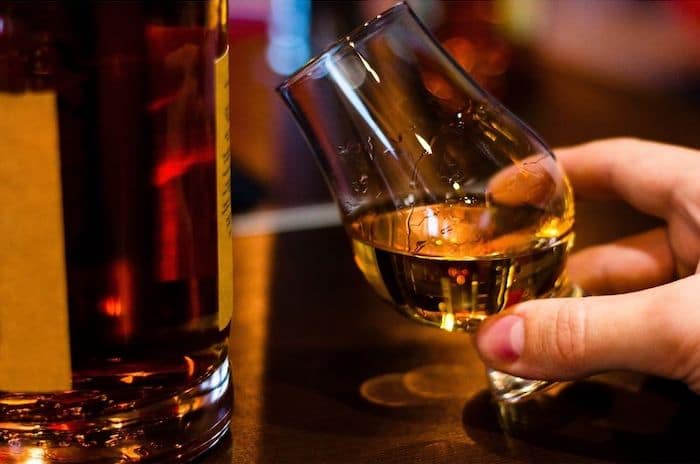
The Brits could have left it at the free interpretation of a dram. However, while this certainly makes sense when poured at home, it does not so much when you intend to sell whiskey by the dram. Then you will need a more precise definition.
Dram, as a unit of measurement, exists in two ways. One is a weight measure, the other the fluid dram we know from drinking whiskey. It initially equaled the above-mentioned 1/8 oz of the spirit.
However, as mentioned briefly, the British Empire decided that from 1973 on, the Anglo-American measurement system should gradually be replaced by the metric system, making a dram of 3.55ml and a hard thing to measure with the new system.
In this case, dramming would not have been much fun, as this is barely enough whiskey to moisten our tongue. So adjustment was inevitable.
To understand that, we introduce another measure: the unit of choice in British pubs once was gill. A gill is the same as a quarter pint (568.26 ml) - too small for a beer and too much for a high-proof liquor.
Therefore, spirits got served in quantities like 1/6, 1/5, or 1/4 of a gill. That converted to shots with 23.7ml, 28,4ml, and 35.5ml. So over time, these common parts of a gill were often called a dram.
So the size of a dram still varied regionally, but now there was a smaller range. As a rule of thumb, you can apply the Distance to London rule: The further away from London, the more whiskey a dram.
Dram - a term for a weight measure - originates from the ancient Greek term Drachma. A Drachma had been the currency, a coin, actually, of Greece until 2002. Then it was replaced by the Euro.
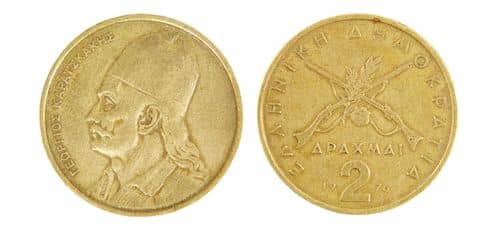
Its Latin translation Dragma was adopted by the French and continued the journey from there into English-speaking countries. That was when it became a dram and was used to measure the physical weight of objects.
Even though a dram is now somewhat standardized for pubs and restaurants, it still widely varies for private events or whiskey distillery tours. Some serve less, some more.
By the way, should you be looking for distillery tours serving drams on the stiff end of the scale, I recommend visiting distilleries on Islay and getting into good graces with the guide. Because, as a Scottish quote says:
"A dram is a measure of Scotch determined only by the generosity of the pourer.”
Are cocktails healthy? Cocktails are bad for your health because they contain alcohol and sugar, right? That is a common opinion and unquestionably true in a lot of cases.
But it doesn't always have to be like that. As a matter of fact, consuming alcohol can even be beneficial for your health.
The high level of antioxidants in alcoholic drinks, especially polyphenolic compounds in red wine, can help our cardiovascular system. They can fight changes in the blood vessels and reduce the effect of high blood pressure and blood sugar.
Those benefits even can outweigh the negative impact of alcohol, making alcoholic beverages more healthy than harmful. The magic key to health benefits through cocktails or other drinks is, you might have guessed it, moderate drinking.
According to extensive studies, cocktails may indeed have a positive impact on your health. Focus is on the "can" because some drinks contain more than the recommended alcohol intake per day.
But a cocktail containing only small quantities of alcohol can surely improve your health and prevent heart attacks. That means moderate drinking plays a key role, and you shouldn't drink more than the recommended amount.
To be fair, the discussion is still ongoing. Even though there are many studies backing the medical benefits of low alcohol intake, there are always new studies proclaiming a strict no-alcohol rule.
For the sake of completeness, the discussion is still ongoing. Although there are many studies that prove the medical benefits of low alcohol consumption, there are always new studies that call for strict abstinence from alcohol.
When reading about the impact of alcohol on our health, you will find the words "moderate drinking" or "moderate alcohol intake" constantly.
Somewhere along the debate about the impact of alcohol, these terms got somewhat blurry. So I first want to establish what moderate drinking actually means.
Many studies define moderate alcohol intake as the number of drinks. Some say one drink per day is fine, yet others state up to three are acceptable, but only for alcoholic beverages with a low ABV.
You probably see the problem already. There is no ultimate definition. A "drink" can be a lot, as we all know. A glass of beer definitely has other effects than a Long Island Iced Tea, so what does a "drink" mean then?
There is now a standard definition trying to create a general baseline. The definition of a drink is:
For all of them, the average content of alcohol is around 12 - 14 grams on average. There are still variations, but we can use this as a guideline.
Based on this definition, moderate drinking means one drink per day for "average" women and a maximum of 1-2 drinks per day for "average" men.
And by one drink, I refer to the quantity in the overview above - We all know that a decent wine glass can hold more than 5oz. But if you're serious about moderate drinking, that's the limit.
Another thing I want to emphasize is the importance of drinking habits.
When you have seven drinks during the weekend while not drinking at all the rest of the week, that's not the same as having one drink per day.
The average may remain the same, but the effects on your body and health don't.
As mentioned already, the primary health benefit of alcohol is that it can lower the risk of cardiovascular diseases. If your moderate alcohol consumption is spread over at least four days a week, this is inversely related to the risk of myocardial infarcts.
The volume seems not to be as essential as the regularity, but it should not exceed 30 grams per day, regardless of your gender.
Studies show a clear correlation between moderate drinking and a reduced risk of cardiovascular diseases. Unfortunately, one promising long-term study got halted due to policy concerns. Its purpose was to prove the positive effects on an international basis. But then, there's enough evidence backing the positive impact through regular, moderate consumption.
More than 100 studies show that consuming alcohol in moderate doses can significantly lower the risks of heart attacks, ischemic strokes, and sudden cardiac death.
To be more precise, it can lower these risks by 25-40%. But, as controversial as it may sound, these numbers are only valid for regular drinking.
On the other hand, increasing the number of drinks per day can have serious harmful effects. It can lead to abnormal heart rhythms, strokes, and heart attacks.
If you want to read more about those studies, I recommend this article from Harvard University.
In addition to the already mentioned benefits, there are other positive effects of a low intake of alcohol.
Moderate drinking can also reduce the risk of diabetes II and gallstones. And social and psychological effects should be taken into account, as well.
Hanging out with your friends while having a beer can effectively improve your general well-being.
Generally, there's no such thing as the "healthiest" cocktail. When talking about the benefits of alcohol, it doesn't matter in which combination we consume it.
But if you want to add to the benefits of your daily drink, look for cocktails with fresh juices, low-sugar components, or ones with an overall low amount of calories.
Yes, it is alright to have one cocktail every day. It can even be beneficial. But stick to the limit of "one drink" as described above, and don't drink too quickly. It's about regularity and not average numbers.
Yes, there are groups of people who should avoid drinking alcohol altogether. The list includes:
Breastfeeding women represent a special group, as this topic is also hotly debated. However, it has been proven that alcohol enters the baby's body via breast milk. Therefore, it is important not to consume alcohol while breastfeeding to avoid possible harm to the baby.
Midori is a bright green melon-flavored liqueur named after the Japanese word for green - Midori. It is made of a neutral base spirit, sugar yubari fruit, musk melon, and brandy. This sweet, fruity liqueur from Japan was first released in 1964.Best known as an ingredient in bright green cocktails like the Japanese Slipper or Midori Sour, Midori was a star of the 80s cocktail scene.
So, here's everything you need to know about Midori Melon - from ingredients to taste to the history of the liqueur.
Midori is a Japanese Melon Liqueur of 20% to 21% ABV produced by Suntory. It is flavored with two types of Japanese melons; -Musk melon and yubari fruit. The result is a sweet-tasting liqueur with a subtle melon flavor reminding me of honeydew melon.
Midori means green in Japanese, so the liqueur is named after its artificially bright green color. The color is also one of its key features and gives any drink made with it a distinct shade of green.
The predecessor of Midori was Hermes Melon Liqueur, released by Suntory back in 1964. To better market the melon liqueur in the U.S., it was rebranded as Midori 14 years later.
It fell into disrepute and lost popularity due to its artificial coloring and sweet taste. But today, it is experiencing a moderate resurgence in cocktails. Used wisely, Midori gives a sweet and subtle melon flavor and a beautiful green color.
The taste of Midori is sweet and has a subtle melon flavor with a hint of mint. You can't really taste the melon type, though. I can best describe it as a mix of honeydew melon and muskmelon. The sweetness is a bit overemphasized and needs balancing. Thus, Midori is best enjoyed in cocktails.

Midori consists of two different types of melons, both similar to cantaloupe but grown only in Japan. One in the North and one in the South of the country. Of course, there's more to it and these two would not achieve the iconic green color. So, here's the full list of ingredients in Midori Melon liqueur:
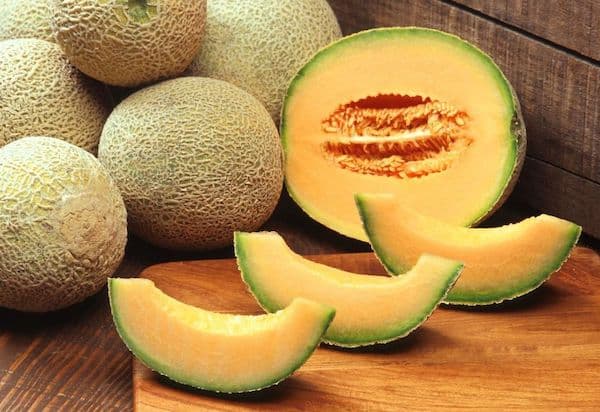
The first step in the production process of Midori is creating an intensely melon-flavored base spirit. This base spirit consists of three parts: A yubari infusion, a yubari distillate, and a musk melon infusion.
All three components are blended into one rich and flavorful spirit of 59% alcohol by volume. It is almost clear, with only a slight shade of orange created by the melon fruit pulp.
The blended melon spirit is then shipped to France and Mexico for further refinement:
Before bottling, the iconic green color comes from adding artificial green food coloring.
The best way to enjoy Midori is in drinks that balance the sweet melon flavor of the liqueur. In combination with lemon juice and spirits, it can make for quite a versatile cocktail ingredient.
It's best when paired with a high-proof base spirit like vodka, gin, tequila, or rum that bring enough bite to counteract the sugary melon liqueur.
Midori Melon is also often part of drinks that contain more than one fruity flavor. Common pairings include lemon, lime, apple, raspberry, and pineapple. However, these are not for everyone and mainly address people who usually go for sweet cocktails.
Midori comes in only one size, an attractively designed bottle of textured glass that shows off the liqueur's bright green color. The combination of the green color and frosted-glass texture of the Midori bottle intends to resemble the surface of musk melon, one of the main ingredients.
The bottle has a rectangular base and is tapered toward the top. It has a small and understated black label and a black bottle cap.
Midori is the result of a lifelong dream of Suntory founder Shinjiro Torii, who always wanted to "create a colorful western-style liqueur".
First released in 1964, the product name was Hermes Melon Liqueur. When this Hermes Liqueur became one of the stars of the 1971 IBA Cocktail Championship in Tokyo, the idea grew to bring it to the American market. Suntory even changed the name of their successful product for this.
In 1978, the liqueur was renamed Midori (ミドリ), meaning "green" in Japanese, for a smoother introduction to the American market, where Hermes - just as in Europe - does not evoke the desired associations... And what an introduction it was.

Launched at the legendary "Studio 54" in New York, John Travolta was one of the first persons to consume Midori in the US. The liqueur immediately gained traction and created a big hype in the 80s.
Until 1987 Midori Melon Liqueur was exclusively produced in Japan. However, when it became a success, parts of the production moved to Mexico and France.
Today, 80-85 percent of the production volume of Midori comes from Mexico. France is producing the remaining 20-25 percent.
In 2013 a new version of Midori containing less sugar was released. That made it taste less sweet and more suitable for modern drinks.
Modifying the recipe was crucial for a successful comeback of Midori. Even more so in a time when people consume more consciously than in the 80s. The bottle design got slightly updated as well and is now frosted glass.
Midori is the first choice for cocktails containing melon liqueur. And because Midori was such hype, we have various cocktail recipes from the 1980s incorporating Midori. Probably the best-known among them is the Japanese Slipper and the Midori Sour.
The Japanese slipper is a three-ingredient cocktail invented by Jean-Paul Bourguignon in Melbourne in 1984. In Australia, this drink is still an icon and on the menu in many bars. If you want to try it, here's what you need.
Ingredients
Preparation
Put the cherry into a chilled Martini glass. Put crushed ice into your cocktail shaker and add all ingredients. Shake well and carefully strain the cocktail into the glass. Garnish it with a slice of honeydew melon, and it's ready to be served.
A Midori Sour is a refreshing cocktail and easy to make at home. You can mix it in a glass. You don't need a cocktail shaker or any other bar tool. With its bright green color and sour taste, it is a perfect summer cocktail.
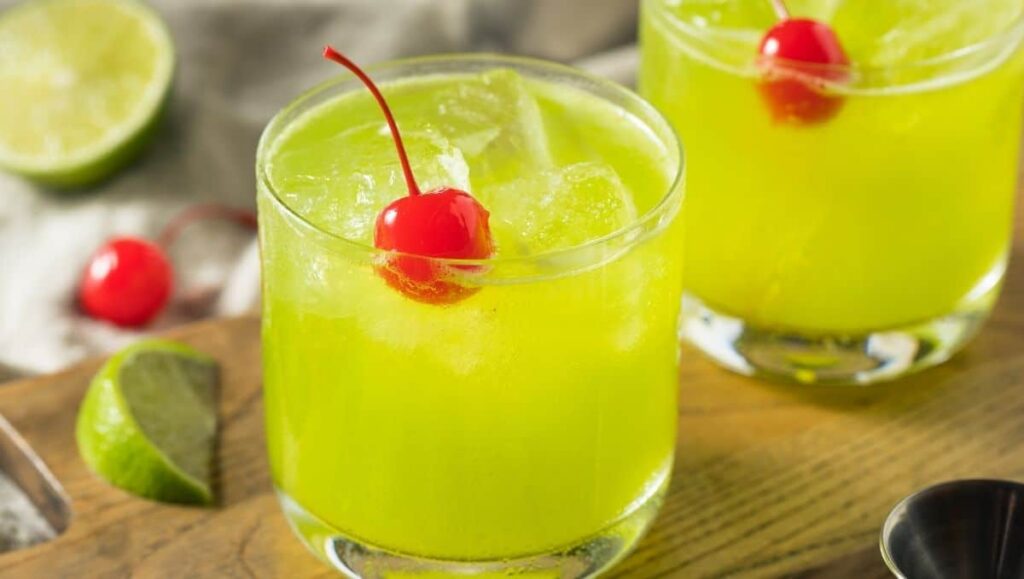
Ingredients
Preparation
Pour vodka, lemon & lime juice, and Midori into a highball glass. Add some ice and stir it well. Finally, top it up with soda and garnish it with a lemon slice.
The bright green melon liqueur from Japan is an excellent cocktail ingredient to create brightly colored drinks. Midori's artificial coloring and borderline sweetness make it a bit controversial. Still, so far, no other melon-flavored liqueur has reached the success of Midori.
Based on a spirit made from homemade coconut and pineapple wine, the taste of Iron Balls Gin reflects its Southeast Asian heritage. The tropical spirit base and botanicals like cinnamon, ginger, and lemongrass make this gin almost inimitable.
Iron Balls Gin comes in a unique bottle shaped like half a cannonball, sealed with a genuine cork stopper. It's decorated with a white label and golden lettering. The handwritten batch numbers, the copper elements on the bottle, every part of this packaging, and the marketing are well thought-out.
The gin reflects its strong Southeast Asian heritage with fruity notes and spices.
When I first smell the gin, I get a lot of fruity notes. The pronounced sweetness of Pineapples mixes with lemongrass, citrus notes, and ginger.
While this is certainly not common, there are a few other, less traditional, Gins with similar nosing profiles.
Tasting Iron Balls neat is a pleasant experience. It's so mild that it's hard to believe that the spirit contains 40% alcohol. On top, it tastes sweet and fruity with notes of pineapple, mango, and citrus. The finish is slightly spicy and brief, with a dominant taste of ginger and lemongrass. What is missing are strong notes of juniper. They do exist but are not as pronounced as you would expect from a Gin.
The tropical and fruity flavors are slightly muted when serving Iron Balls Gin on ice. In return, you get a more pronounced juniper taste. However, overall, I prefer the flavors when sipping it neat as then, the gin is not only fruitier but also more complex.
Our review on Iron Balls Gin in classic gin drinks:
An Iron Balls Gin and Tonic is best served with a slice of pineapple and some Thai Basil leaves. It is fresh, vibrant, fruity, and refreshing like no other Gin and Tonic I have drank before.
The tropical vibes immediately take me back to the beaches of Thailand. The combination of mango, pineapple, Thai basil, and spice is gorgeous, and you need to remind yourself that this drink is beverage is an alcoholic drink and that you should not drown in one big gulp.
I suggest slightly increasing the ratio of gin to tonic. A 1:2 ratio instead of the standard 1:3 made the drink even better.
In a standard Negroni, Campari and sweet vermouth cover the delicate fruity flavors almost entirely. However, in our Coconut Negroni mixed with Coconut Rum (I like to use Mahiki), the balance of flavors was much better. The addition of coconut rum emphasized the coconut flavors and highlighted the fruity flavors of the gin.
I really liked the taste of Iron Balls in a Martini. The rather sweet and fruity flavors require a better balance, though. We tried the classic dry vermouth options first like Noilly Prat and Dolin, but we found Riserva Carlo Alberto the best fit.
The fruity notes worked surprisingly well. Also, the balance between sweet and bitter is just right, making Iron Balls an excellent base for a Martini.
Iron Balls Gin is distilled in the heart of Bangkok, making it one of only a few Gins produced in Thailand. The distillery is located right in one of the most exclusive and popular areas of the city, inside the associated bar called the Iron Balls Distillery.
You can literally walk from the bar counter to the still with ten steps. I've never seen a similar setup, but it looks and feels surreal to be sipping your drinks so close to the machine that produces the gin in your drink.
Details about the ingredients or botanicals used in the Iron Balls Gin are kept secret from the public. Only a few botanicals- juniper, hillside ginger, lemongrass, coriander seeds, coconut, pineapple, and citrus fruits - are known to be part of the recipe.
When joining the distillery tour, I also learned that, instead of regular grain spirit, Iron Balls uses a concoction of fermented pineapple and coconut to create a kind of wine. This base then gets distilled into a pineapple-coconut Vodka.
Besides that, there is not much information on the contents. So I will make a guess based on its taste. Tasting and nosing the spirit there are some hints that the following ingredients could play a role in the Iron Balls Gin:
Do keep in mind that I base this on speculation. The actual ingredients are not confirmed.
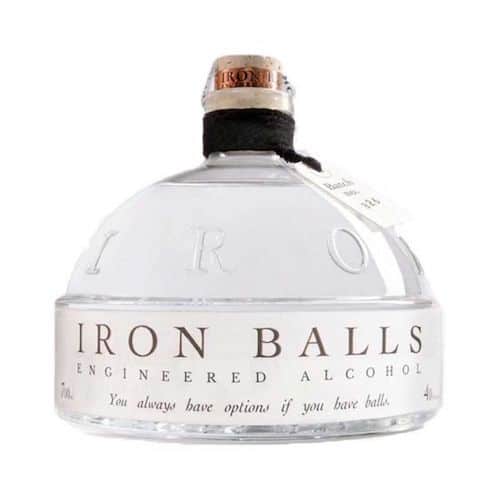
Just by admiring the attention to detail in the bottle design, you can get an idea of how much effort was put into the creation of this product. The handcrafted bottle is shaped like a cannonball, uses genuine cork to seal the bottle, and has handwritten batch numbers.
There is no denying it. I am totally in love with this gin. But from a more objective point of view, this is an excellent New Western Dry Gin you definitely should try.
It pushes the limits of the Gin definition and delivers on taste and design. The price usually is around $60 - in liquor stores and when buying it directly in the distillery.
Kvass, sometimes also spelled Kvas, is a Russian grain drink with a low level of alcohol. The traditional, fermented refreshment is produced from Russian wheat, rye bread, and beets. The result is a sweet drink with notes of toasted bread and a slightly tangy bite. Not only is Kvass delicious, but it is also healthy and very nutritious.
Yet the best about the fermented drink is that you only need a few things to make it. -Some leftover bread and a small set of additional ingredients to initiate fermentation.
Jump To Recipe | What is it? | Ingredients | How to make it? | Which Yeast? | Duration of fermentation | Add flavor to the recipe | Tips to make it better | Is it good for your body? | History | Kvass vs. Kombucha | FAQs
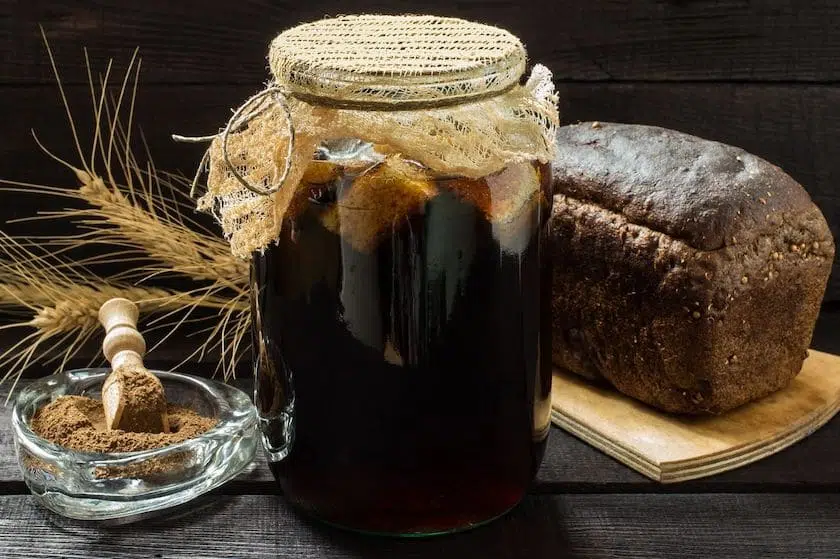
Kvass is a traditional low-ABV fermented drink, most famous in Russia and Eastern Europe. Usually, you use leftover bread (bread kvass), but you can also make it from beets (beet kvass) or even fruits (fruit kvass).
It has a sweet taste, comparable to honey, but with malty and bready notes; the flavor is probably best compared with malt beer. Due to the fermentation process, the beverage has a light carbonation and a low amount of alcohol.
Homemade Kvass typically contains anywhere between 0.5% to 2.5% alcohol by volume. Commercial products like Imperial Kvas often contain more, about up to 4% ABV.
Depending on which type of Kvass you want to make, the list of ingredients is different. In our case, it will be Bread Kvass from old rye bread, water, a sweetener like honey, and yeast.
To spice things up and add more flavors, you can extend the recipe with spices, herbs, fruits, and other sweeteners.

If you want to make Bread Kvass, you have to follow four basic steps. The whole process takes quite a while, but the amount of work you need to put in is limited.
Altogether, you will only spend a few minutes prepping the fermentation and another few bottling and preparing the "bottle conditioning".
Yeast and good bacteria do the rest of the work, which turns your old, stale bread into a bubbly and alcoholic beverage.
Our recipe works with instant yeast. To kick off fermentation, Kvass requires a starter culture. You can use a sourdough starter, but also baker's yeast or ordinary bread yeast is fine.
When you want to replace instant yeast with something else, you need to adjust the measurements accordingly:
For example, brewer’s yeast is more active. Therefore, you need way less to get the same results. For our recipe, half a tablespoon would be enough.
Here's an overview of the different yeast options to make Kvass and how they can affect the final product.

Our general indication: the process should take between 2 and 7 days. After 48 hours, you can taste it and check the carbonation. It should already be a bit sour with a hint of sweetness.
Homemade Kvass is all about balancing flavor and fizz. You want to let it ferment long enough to get that sourness and carbonation without letting it get overly sour.
Traditionally, carbonation is relatively low. Yet, because we are getting more used to strongly carbonated beverages, the traditional version would not taste right.
The longer you ferment the Kvass, the more tangy its flavor will be. So taste regularly to avoid an overly sour result. Once it tastes right, filter it through a fine-mesh strainer and bottle it.
Our Kvass recipe includes raisins to add a bit of flavor and additional sweetness. But there are plenty of other ways to bring flavor to your drink, from herbs to spices to fruits.
The whole process of making Kvass is pretty straightforward. If you follow the steps in our easy recipe, you can easily make it at home. Still, we have a few tips that will improve the quality of your homemade Kvass.
Like other fermented beverages such as Kombucha or Tepache, Kvass is rich in nutrients and a great source of beneficial bacteria. Here's a quick overview of the health benefits associated with drinking Kvass:
The origin of Kvass is a lot older than Russia itself. The first written evidence goes back more than 1,000 years. Location-wise, the recipe traveled from Ancient Egypt, Babylon, and Greece all the way to what is known today as Russia. That was long before Vodka or the Cyrillic alphabet was invented.
Back then, people already knew about the healing qualities of the beverage. The fact that it was safer than water made it an everyday drink for everyone, even kids.

It may sound odd by today's standards, but back then, it was a natural solution to compensate for the lack of clean water and also a way to reduce food waste:
Boiled water was poured over old and stale bread, and its high temperature killed many pathogenic bacteria, which potentially could make people sick.
Additionally, during fermentation, the lactic acid bacteria convert sugar into lactic acids, acetic acids, and carbon dioxide. These compounds help fight pathogens and make food and drink even safer for consumption.
In the 1700s, fermented Kvass was the most popular beverage for people from all social classes in Russia. It was part of daily life.
In the 1900s, the love for the fermented drink still was so great that it got the name communist Coca-Cola, linking Kvass to the most famous American refreshment.
While kids in America used to line up in front of ice cream trucks on hot summer days, Russian kids lined up for another refreshment - Kvass. At times when sodas and soft drinks were rare, that was a real treat.
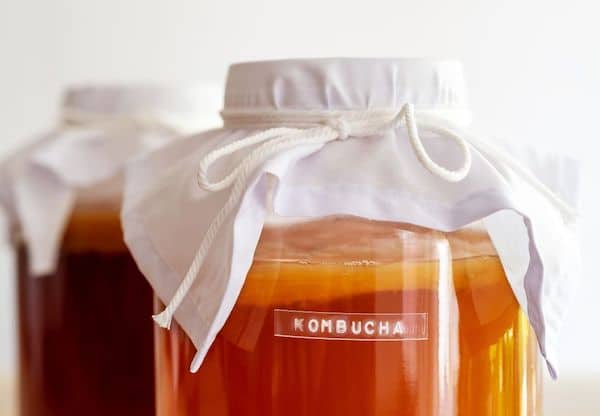
Kombucha and Kvass are both lactic acid-based fermentations. While the probiotic benefits of are pretty similar, the two beverages still are very different.
For instance, while Kvass can have various base ingredients, Kombucha offers only one option - sweetened black tea. Also, when making Kombucha, you need a specific starter culture called ‘SCOBY’.
Scoby stands for Symbiotic Colony Of Bacteria and Yeasts. That consists of a mixture and balance of strains, very specific for creating Kombucha.
Further, the fermentation duration is quite different. While Kvass needs between 2 - 7 days, Kombucha usually takes 5 - 30 days of fermenting at room temperature.
Yes, just like other fermented beverages such as Kombucha and Tepache, Kvass does contain a low amount of alcohol. -Typically between 0.5% to 2.5% ABV.
Theoretically, yes. However, you would need to drink enormous amounts of homemade Kvass to get drunk.
Bread kvass, the most common type, is made of rye bread, thus, not gluten-free. But you can make gluten-free fruit kvass or beet kvass instead.
Stored in the fridge, homemade Kvass will keep for one week (7 days). Commercially produced Kvass lasts significantly longer.
Especially with Bread Kvass, you want to store the bottles in the fridge. That ensures that it lasts for up to one week.
If your Kvass turned bad, you usually are able to see it. If you see any signs of mold or slimy texture or are greeted by a weird smell when opening the bottle, discard it.
Usually not. But as with any fermented drink, Kvass produces carbon dioxide during fermentation, which increases pressure in bottles and jars. If you do not open them now and then, your vessels could potentially burst.
No, the color and the slight carbonation could make you think it is some sort of beer, but it is not. Kvass is a fermented drink like Kombucha or Tepache.
The taste of Kvass is best compared to malt beer: sweet with a malty and bready flavor and a slightly bitter note.
There are many popular Kvass Brands and the best-known are Põrgu Kali, Ochakovsky, Jester King, and Fonta Flora.